A classic treat for Dragon boat festival. With this informative recipe, you will make sweet and savoury Zongzi, Chinese sticky rice dumplings, with great ease.

Jump to:
What is Zongzi
Zongzi (粽子, Chinese sticky rice dumpling) is a traditional food for celebrating Duanwu festival (端午节, aka Dragon boat festival) which is on the fifth day of the fifth month of the Chinese lunar calendar (The exact date varies on a regular calendar each year).
The Dragon Boat Race isn’t a tradition in the North-west of China where I grew up. But Zongzi is definitely an indispensable delicacy that makes this festival very attractive and special.
Zongzi is basically glutinous rice with sweet or savoury fillings wrapped in bamboo or reed leaves. After being cooked in water, all the ingredients stick together and stay in a particular shape when unwrapped.
It’s a sticky, aromatic and flavoursome treat that involves some very specific preparation. But it’s worth every bit of effort as it tastes so good!
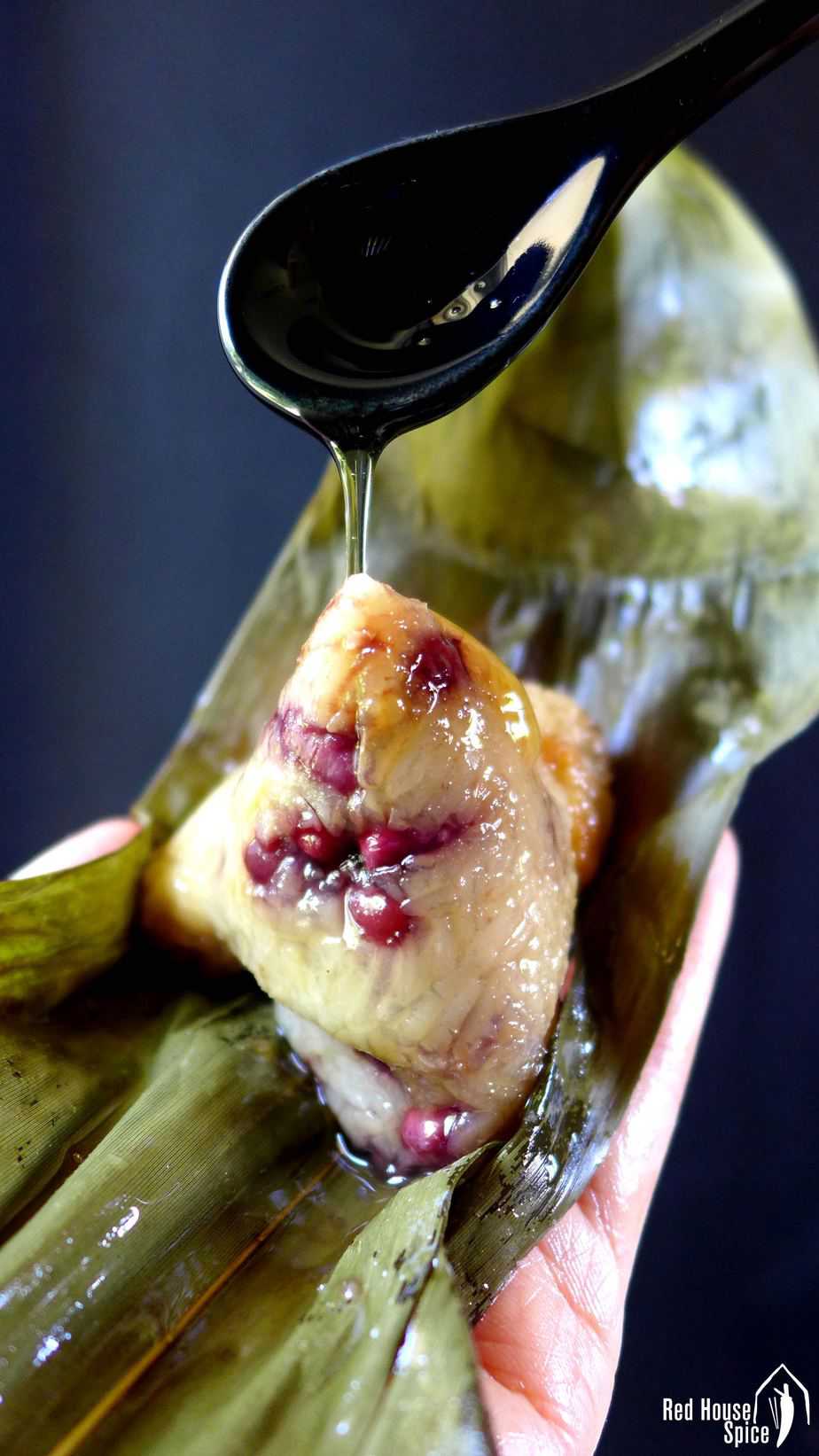
A person memory
I felt extremely homesick when I was preparing and shooting Zongzi for this post. The strong aroma that lingered in my kitchen for hours brought me back to those good old days. Thanks to my mum and dad who always involved me in the kitchen, I had many sweet childhood memories about Zongzi.
I remember on those early summer days right before Duanwu festival, my mum would ask me and my brother to collect Ma Lian (马莲, a type of long, tough grass used to tie the Zongzi instead of strings) in the nearby field. We were then given the opportunity to wrap the Zongzi.
It was very tricky for young children and most of the time we ended up with broken leaves and spilt rice. But my parents always acknowledged our effort and encouraged us to try again and again. We often didn’t have that patience to stay right to the end of the preparation, but we got our hands wet and had lots of fun.
I remember how much I loved the aroma coming from the pot in which the Zongzi was boiled. It was so nice and memorable! I also remember how comforting it was to have a cold Zongzi as a snack after a tiring day in school.

Two varieties: sweet & savoury
There is a large variety of Zongzi across China. They differ in size, shape and filling. Growing up with sweet Zongzi stuffed with red beans and/or Chinese dates, I encountered culture shock the first time I heard of savoury ones.
Having meat as the main filling is very popular in the southern regions of China such as Shanghai, Canton, etc. You may also find them filled with salted egg yolks, chestnuts, dried shrimp, etc.
Obviously sweet and savoury Zongzi are very different in taste, but I think they are equally delicious! That’s why I’d like to introduce both versions in this post.
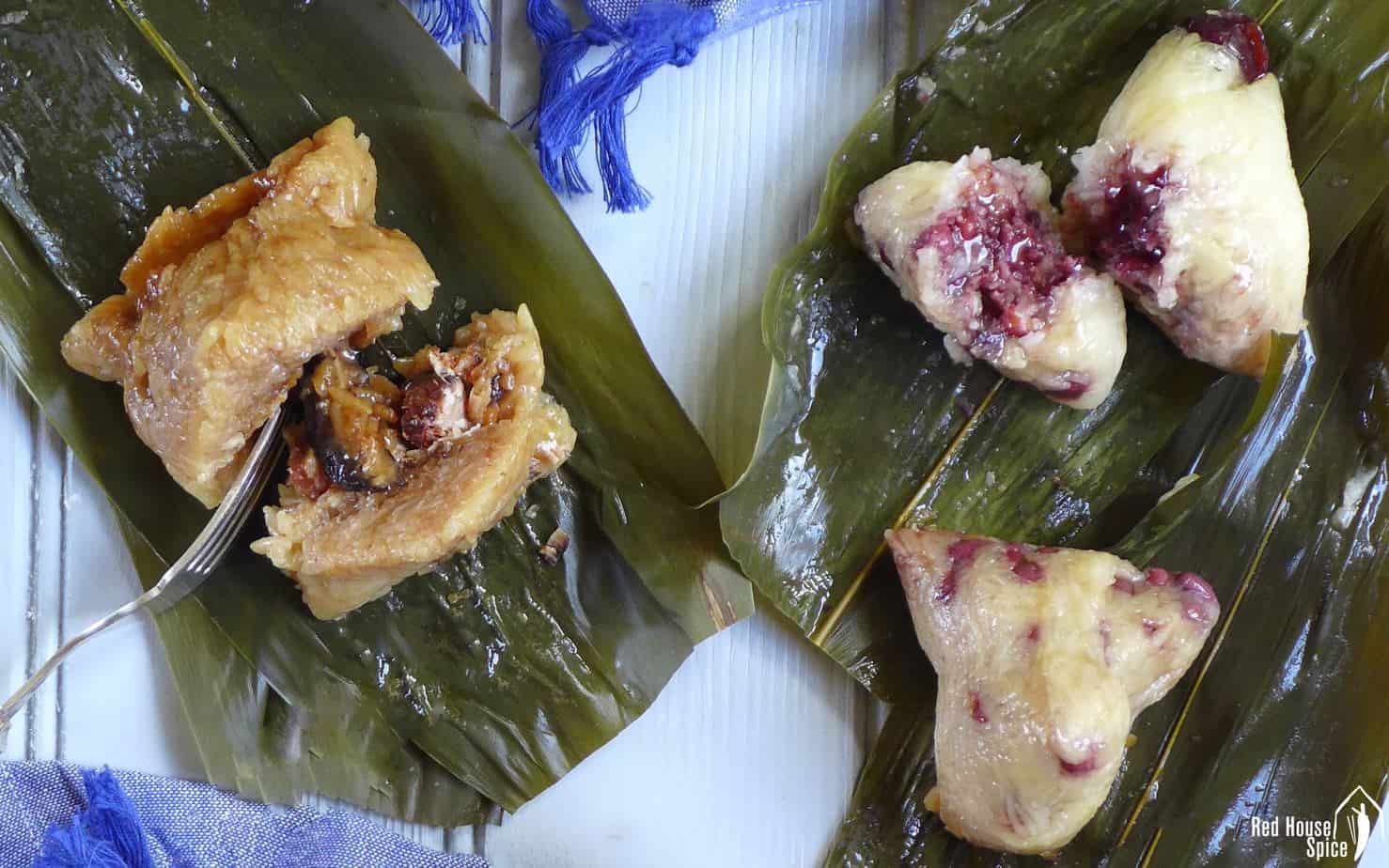
Sweet Zongzi with red beans
Red beans (aka adzuki beans) are widely used in Northern-style sweet Zongzi. In my recipe I put red bean paste in the middle (a sweet surprise when cut open) then sprinkle whole red beans on top of the rice (a nice look and bite on the surface).
I also like putting a Chinese date in each Zongzi to add a different sweet taste. In fact, you can be flexible and creative with the filling. For example, mung beans and dry fruits work well too. Just remember to soak hard ingredients like beans overnight beforehand.
Usually, sweet Zongzi are served with either honey or sugar. It’s delicious both warm and cold.
In this post, I wrap sweet Zongzi into a triangle shape: it has four corners and four triangle sides. You need a minimum amount of bamboo leaves to make this shape: one wide leaf or two overlapped narrow ones for each Zongzi. It’s ideal for small Zongzi.
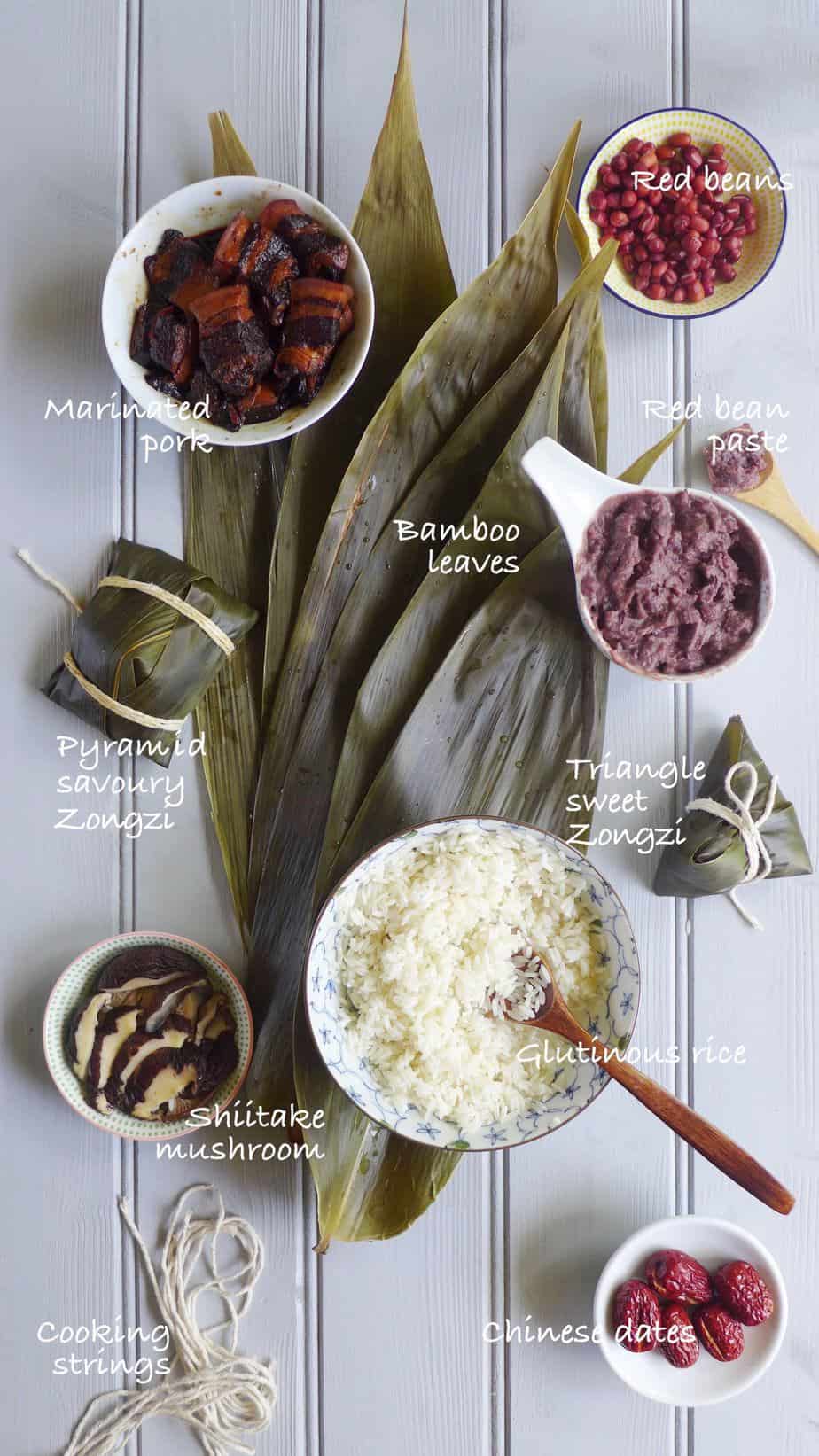
Savoury Zongzi with pork belly
The savoury version requires two fillings: marinated pork belly and shiitake mushrooms. After cooking, the flavour from the pork marinade penetrate into each grain of rice. The meat becomes so tender that it almost melts in your mouth. You may serve meaty Zongzi warm, as breakfast, snack or as a staple of a dinner.
I tried a different shape for the savoury ones. You need four bamboo leaves to wrap everything into a five-corner, pyramid shape. It’s bigger than the triangle ones and I find it easier to wrap. If you are new to wrapping Zongzi, I recommend that you start with this wrapping method.
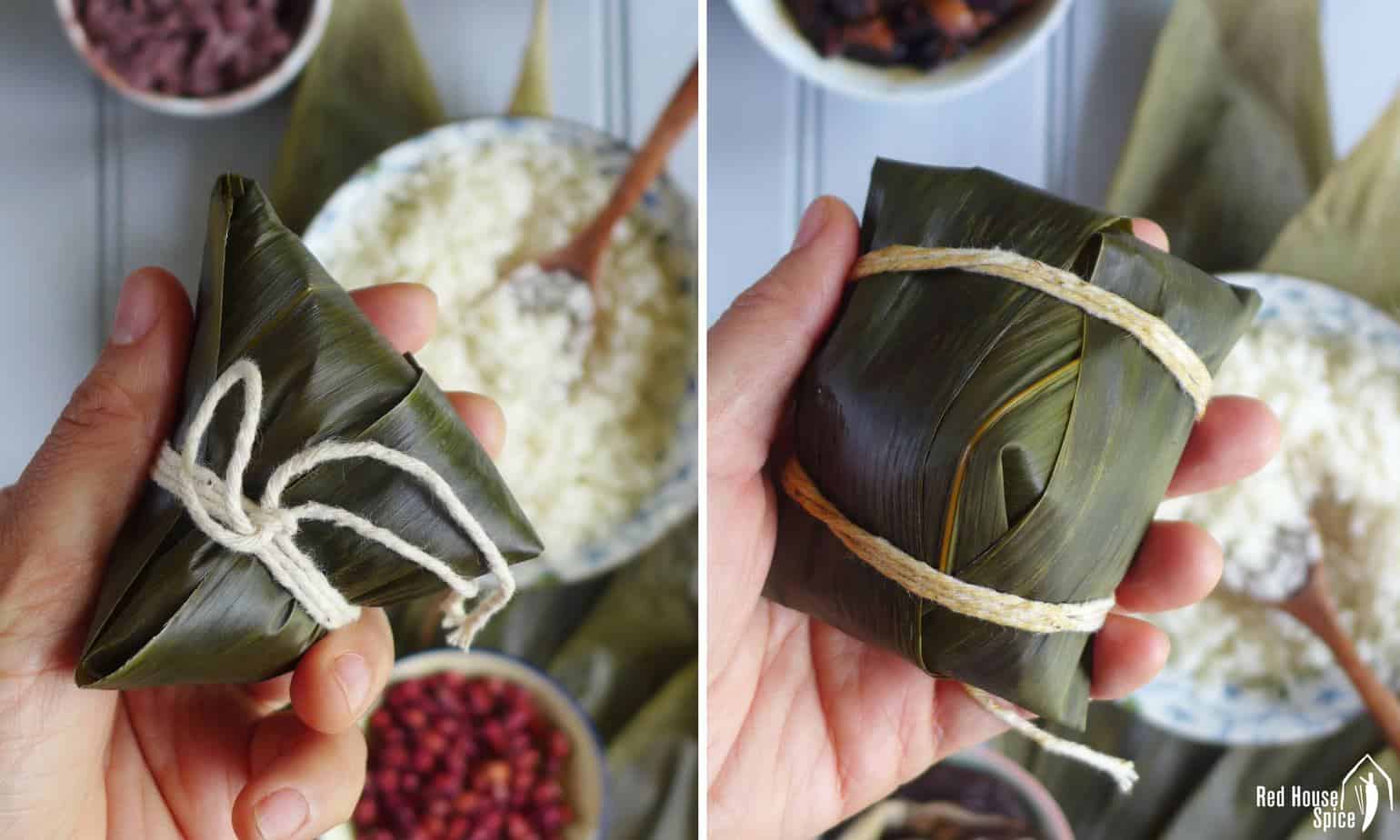
How to make Zongzi?
Step 1: Prepare the ingredients
This means to soak the hard-to-cook ingredients (rice, red beans) in water beforehand and to marinate the meat if you are making savoury ones.
I use dried bamboo leaves (widely available in Chinese/Asian shops) that need to be soaked too. They should be pliable when wrapping.
Step 2: Assemble and wrap
This is probably the most intimidating part. Actually it’s not that hard at all (please see my detailed instructions below). I think the key point is to be patient. Take your time and do not rush.
Step 3: Cook the Zongzi
They need to be boiled in water for about 2.5 hours. You should place a heavy plate on top of the Zongzi to stop them floating (my mum used to put a flat stone instead). Don’t forget to check the water level from time to time. Top up to ensure the Zongzi are always underwater.
PS: My mum used to boil some eggs with the Zongzi. The aroma from bamboo leaves makes them super tasty. It’s a bonus!
🛎 The Alkaline Version: In southern regions of China, yellow-coloured Alkaline Zongzi (碱水粽) is very popular. To make this version, add 1 tablespoon of lye water (Kansui) to the soaked glutinous rice (weigh 600g/21oz before soaking). Follow other instructions as usual.
Two ways to wrap
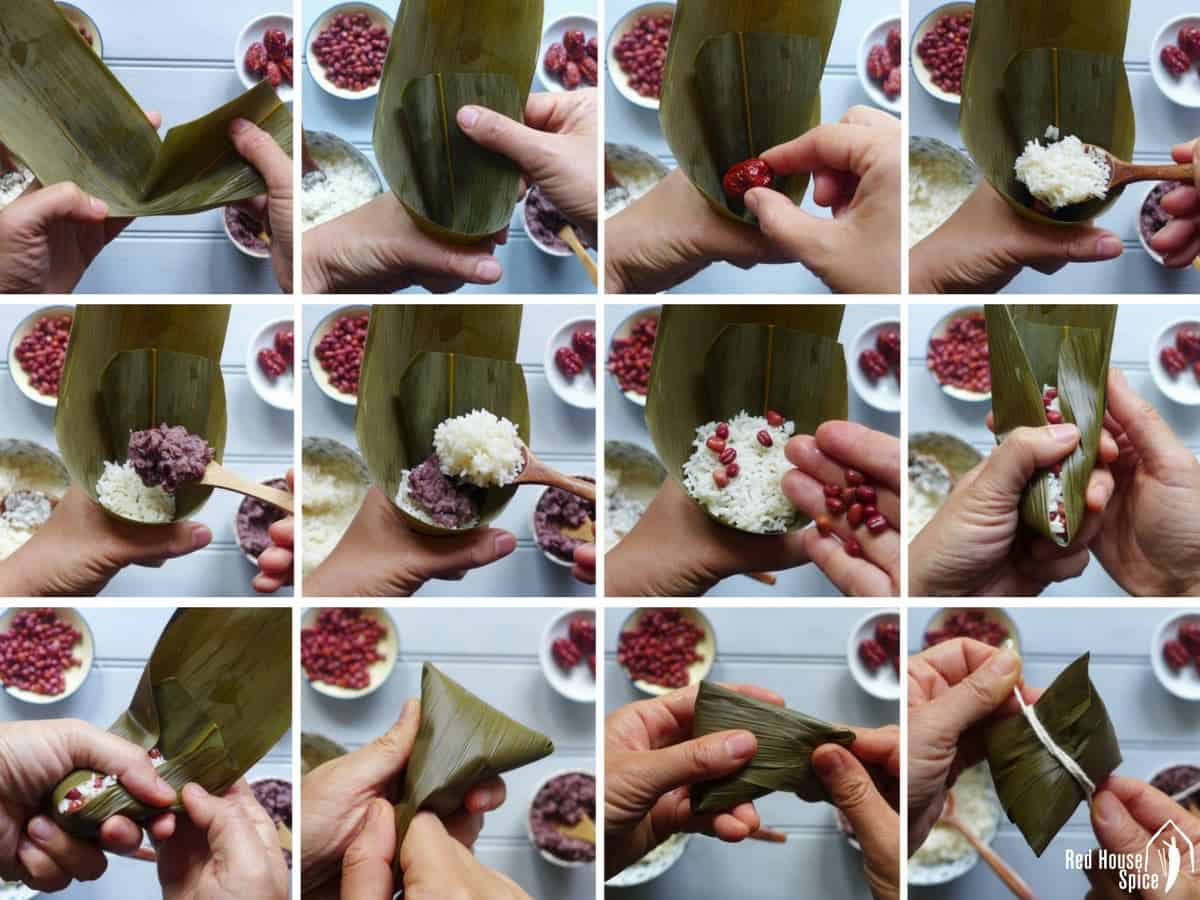
Triangle shape
- Use one wide bamboo leaf (or two overlapped narrow ones) to form a narrow cone.
- Place some glutinous rice in, then the filling.
- Top with more rice and make it level.
- Fold the two sides of the leaf over the rice.
- Then fold the top of the leaf down to cover the rice completely.
- Wrap the rest of the leaf around the shape. Tie with a cooking string.
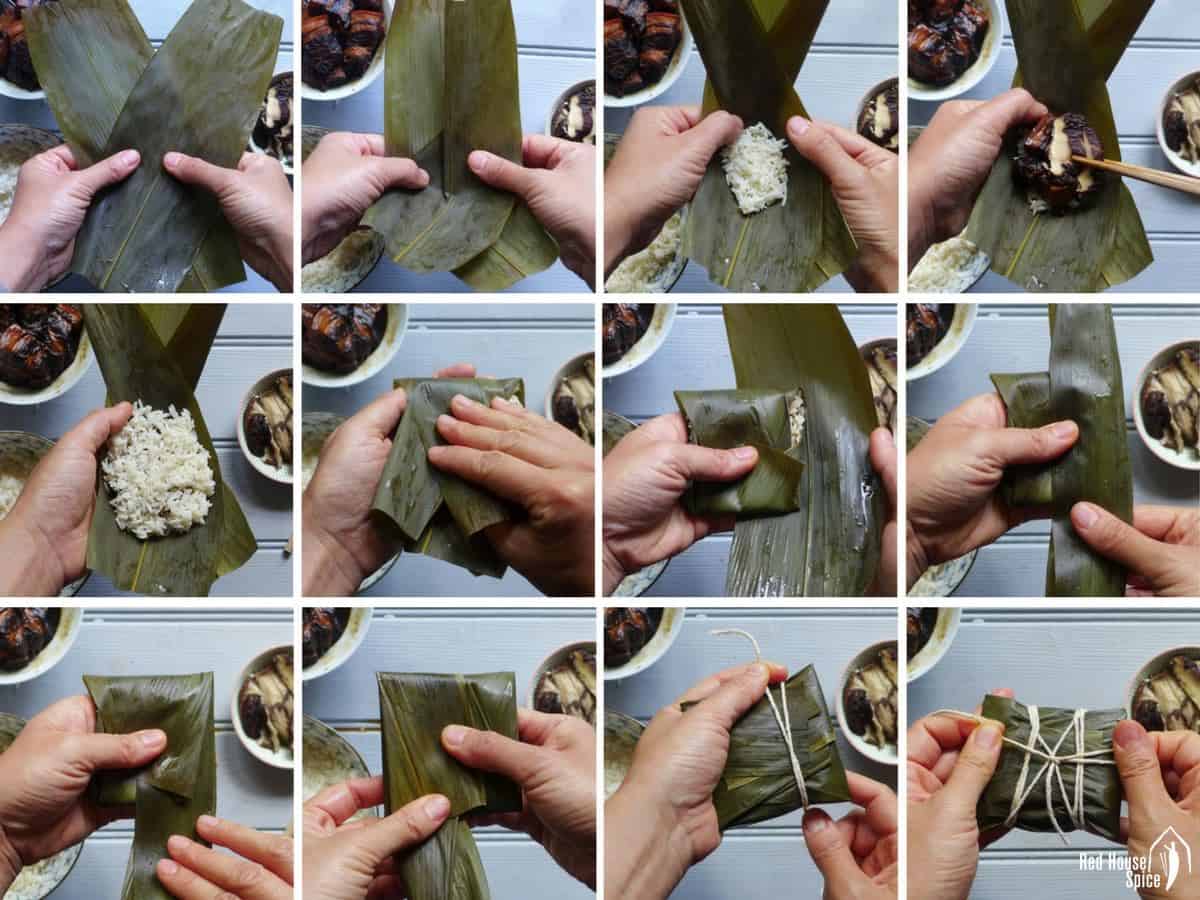
Pyramid shape
- Overlap two leaves like an X. Form a wide cone in the middle.
- Place some glutinous rice in, then the filling.
- Top with more rice and make it level.
- Fold two ends of the leaves towards the middle.
- Then use another two leaves to seal two sides.
- Tie with a cooking string (opposite direction of the last two leaves).
Other sticky rice recipes
Looking for more ideas to cook with glutinous rice? Check out these recipes:
📋 Recipe
Love this recipe? Please leave a 5-star 🌟🌟🌟🌟🌟 rating in the recipe card below & if you REALLY like it, consider leaving a comment as well!
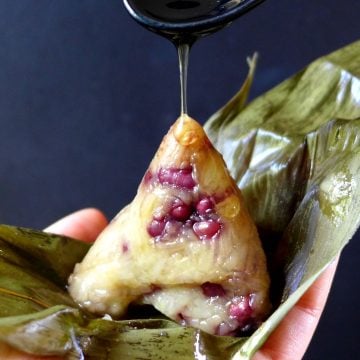
Zongzi: Chinese sticky rice dumpling (粽子)
Ingredients
For the sweet Zongzi made in triangle shape
- 600 g glutinous rice - 21oz
- 4 tablespoon red bean paste - aka adzuki bean paste
- 4 tablespoon red bean - aka adzuki beans
- 12 Chinese dates - pitted
- 12-24 bamboo leaves - two ends trimmed
- 12 cooking strings - 70cm/27inch each
- Honey or sugar - for serving, optional
For the savoury Zongzi in pyramid shape
- 600 g glutinous rice - 21oz
- 6 shiitake mushrooms
- 200 g pork belly - cut into chunks
- 2 tablespoon light soy sauce
- 1 tablespoon dark soy sauce
- 1 tablespoon Shaoxing rice wine
- ¼ teaspoon Chinese five-spice powder
- 1 pinch white pepper
- 1 pinch salt
- 1 pinch sugar
- 1 teaspoon ginger - minced
- 48 bamboo leaves - two ends trimmed
- 12 cooking strings - 125cm/50 inch each
Instructions
For the sweet Zongzi
- Prepare: Soak glutinous rice, red beans and bamboo leaves in water overnight.
- Assemble (triangle shape): Use one wide bamboo leaf (or two overlapped narrow ones) to form a narrow cone. First, place a date in the cone, then some glutinous rice. Add a tablespoon of red bean paste. Top with more rice and whole red beans. Fold the two sides of the leaf over the rice. Then fold the top of the leaf down to cover the rice completely. Wrap the rest of the leaf around the shape. Tie with a cooking string. Please refer to the video below.
- Cook: Place Zongzi in a pot (ideally small enough to let them snuggle). Fill the pot with water completely covering the Zongzi. Place a heavy plate on top. Bring the water to a boil then leave to simmer for 2.5 hours (check the water level from time to time. Top up to ensure the Zongzi are always underwater).
- Serve: Equally delicious both warm and cold. Dip into sugar or honey for a sweeter taste if you wish.
For the savoury Zongzi
- Prepare: Soak glutinous rice, shiitake mushrooms and bamboo leaves in water overnight. Marinate the pork with the rest of the ingredients overnight.
- Assemble (pyramid shape): Overlap two leaves like an X. Form a wide cone in the middle. Place some glutinous rice in, then the pork and mushroom. Top with more rice and make it level. Fold two ends of the leaves towards the middle. Then use another two leaves to seal two sides. Tie with a cooking string (opposite direction of the last two leaves). Please refer to the video below.
- Cook: Same as cooking sweet Zongzi (see above).
- Serve: Best to serve warm.
Video
NOTES
NUTRITION
NUTRITION DISCLOSURE: Nutritional information on this website is provided as a courtesy to readers. It should be considered estimates. Please use your own brand nutritional values or your preferred nutrition calculator to double check against our estimates.
I had great pleasure in making these Zongzi and writing this post. It reminds me of where I come from and what is important in life. I’d love to take this opportunity to say THANK YOU to my wonderful parents who filled my childhood with happy memories through food.



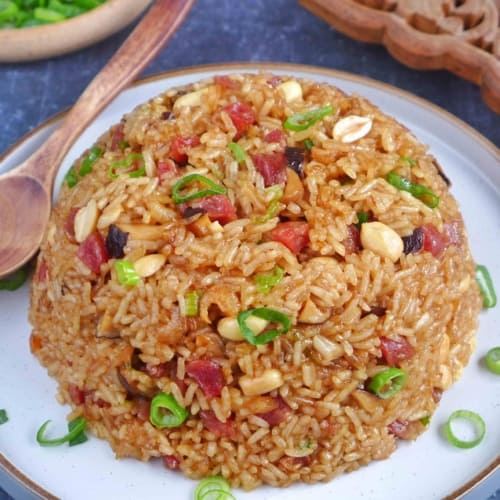
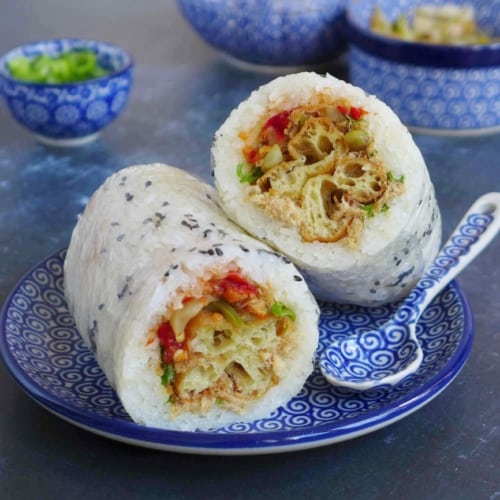
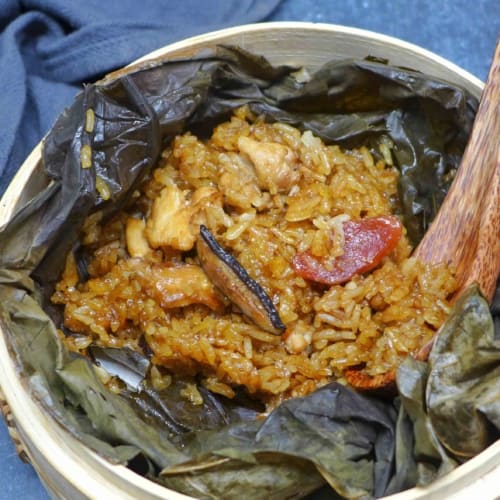
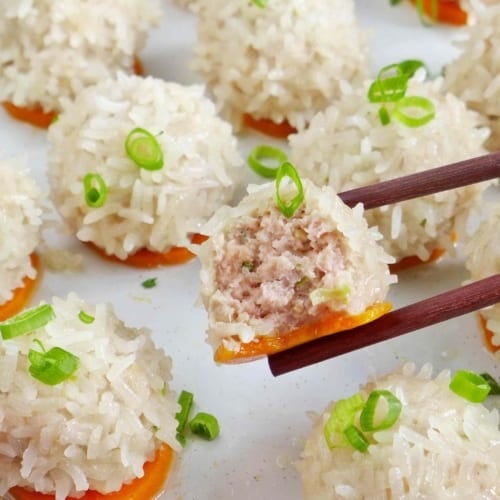
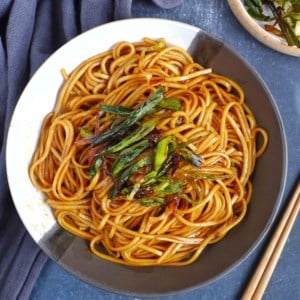
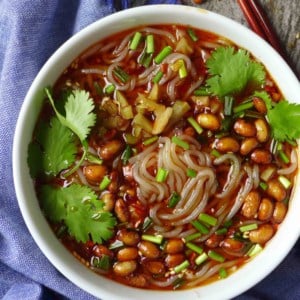
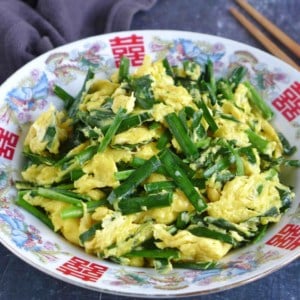
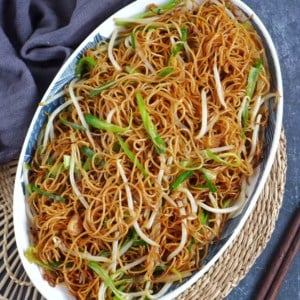
Can you pressure cook these?
Yes, you can use a pressure cooker. Cook for 1 to 1.5 hours. Let the pressure release naturally.
Thank you so much for your great work! It is really helpful.
You’re welcome Aijie! Hope you’ve had a wonderful Dragon Boat Festival!
Does the pork need to be pre-cooked, or do you just add it in marinaded?
Hi Lemon! No need to pre-cook the pork. Just add marinated pork pieces inside the rice as the recipe suggests. Happy cooking!
Wei, you are amazing.
Thank you for creating your delightful blog.
Your palpably authentic and humble; and it shows on every page.
Your stories of growing up, sharing kitchen experiences with your mum and family are heart warming for me and must have triggered some kind of past life memory because they trigger tears of knowing, every time.
You have a love of food and cooking, a deep understanding of your culture and cuisine, a bursting enthusiasm to share and teach (captured in your wonderfully clear and simple instructions), and you have a polished penchant for culinary photography! (My god, I find myself wanting to bite the end of each jpg…just to sneak in a little taste test!)
I LOVE all Asian cuisine; especially Chinese!…actually double special when it’s little treats like Zongzi!
Guess what my new home screen book page is now? 🙂
Can’t wait to cook every one of your dishes!
And guess what? My kids are about to get a lot more playing around time with dad in the kitchen lol
But what they don’t know is that they’ll be “secretly” learning to become dumpling experts! 😀
Just wait, Wei…I can see the day they turn around to text their friends,
“You know the dumplings I make and take to school each day? Yeah, well there boss better than MacDonalds…waaay better! Like for real!”
Can’t wait to see that. That would be a good day to claim “family tradition” :)) anyway, that’s what I’m feeling..
Thank you Wei, for bringing a smile and happy tears to my face.
Sending you and your family blessings and good fortune.
Rad, zài jiàn
PS: mandatory, first aroma to fill the kitchen will be sweet red bean paste steamed buns! OMG! Sooo good!
Did you know when they cool down you can stuff a few in each pocket before you go out for the day? 😮 …no joke, great snack! 😀
Did I mention I like dumplings? :p
Thank you so much Rad for taking time to write such a heart-warming message. I appreciate very much your understanding of my passion for sharing and my deep love for my culture. So happy to know you are getting your children involved in the kitchen. It’s one of the best places to learn life lessons. They will treasure all the experiences for many years to come. Stay safe and enjoy more yummy food!
PS, I love red bean buns too!
I am so excited to try these recipes! I am completely unfamiliar with Chinese dates, and found some dried, deseeded ones at my local Asian grocery; do these need to be soaked, or will they soften with cooking?
Thank you!
Hi Susan! It depends on the condition of your dried dates. If they are very wrinkled and feel hard when squeezing, you need to snack them in water in advance (Just like how you soak the rice). If your dates are lightly wrinkled and kind of springy when squeezing, you don’t need to soak them. Hope this helps. Happy Dragon Boat Festival!
does the rice have to be cooked before wrapping? or will it be cooking when it is boiled for 2 hours?
Wrap pre-soaked raw rice. It will be cooked during the simmering process.
Thanks for sharing your personal experience and recipes. I linked to this blog from my podcast’s show notes to share this great food with my listeners.
My pleasure Michael! Do you mind sharing a link to your podcast?
They look delicious! Thank you for sharing your memories and recipes! 🙂
My pleasure Lori! Glad to know you find it appetizing.
I have had green beans mixed with the glutinous rice. How would you do that?
By saying “green beans”, I guess you mean mung beans (绿豆). If so, soak mung beans with glutinous rice overnight then wrap with bamboo leaves and cook them the usual way.
Hi! As you can see in my post and recipe, I introduce two types of Zongzi: sweet one with red bean paste filling and savoury one with pork filling. The former is vegetarian. In fact, you may choose other fillings that you prefer and sometimes people have plain ones too (without any filling). Hope this is helpful to you. Happy cooking!
Is the pork an essential ingredient? Can it be taken out to make vegetarian?